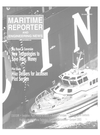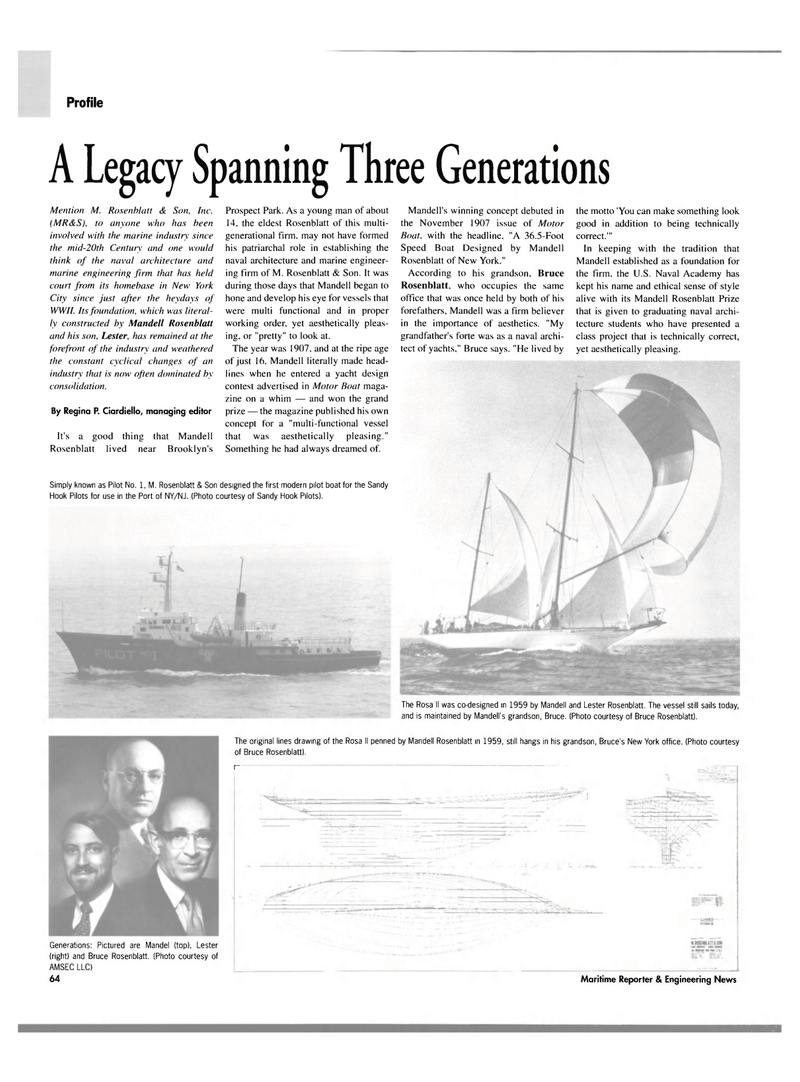
Page 66: of Maritime Reporter Magazine (October 2003)
Read this page in Pdf, Flash or Html5 edition of October 2003 Maritime Reporter Magazine
Profile
A Legacy Spanning Three Generations
Mention M. Rosenblatt & Son, Inc. (MR&S), to anyone who has been involved with the marine industry since the mid-20th Century and one would think of the naval architecture and marine engineering firm that has held court from its homebase in New York
City since just after the heydays of
WWII. Its foundation, which was literal- ly constructed by Mandell Rosenblatt and his son, Lester, has remained at the forefront of the industry and weathered the constant cyclical changes of an industry that is now often dominated by consolidation.
By Regina P. Ciardiello, managing editor
It's a good thing that Mandell
Rosenblatt lived near Brooklyn's
Prospect Park. As a young man of about 14, the eldest Rosenblatt of this multi- generational firm, may not have formed his patriarchal role in establishing the naval architecture and marine engineer- ing firm of M. Rosenblatt & Son. It was during those days that Mandell began to hone and develop his eye for vessels that were multi functional and in proper working order, yet aesthetically pleas- ing. or "pretty" to look at.
The year was 1907. and at the ripe age of just 16. Mandell literally made head- lines when he entered a yacht design contest advertised in Motor Boat maga- zine on a whim — and won the grand prize — the magazine published his own concept for a "multi-functional vessel that was aesthetically pleasing."
Something he had always dreamed of.
Simply known as Pilot No. 1, M. Rosenblatt & Son designed the first modern pilot boat for the Sandy
Hook Pilots for use in the Port of NY/NJ. (Photo courtesy of Sandy Hook Pilots).
Mandell's winning concept debuted in the November 1907 issue of Motor
Boat, with the headline, "A 36.5-Foot
Speed Boat Designed by Mandell
Rosenblatt of New York."
According to his grandson, Bruce
Rosenblatt, who occupies the same office that was once held by both of his forefathers, Mandell was a firm believer in the importance of aesthetics. "My grandfather's forte was as a naval archi- tect of yachts," Bruce says. "He lived by the motto 'You can make something look good in addition to being technically correct.'"
In keeping with the tradition that
Mandell established as a foundation for the firm, the U.S. Naval Academy has kept his name and ethical sense of style alive with its Mandell Rosenblatt Prize that is given to graduating naval archi- tecture students who have presented a class project that is technically correct, yet aesthetically pleasing.
The Rosa II was co-designed in 1959 by Mandell and Lester Rosenblatt. The vessel still sails today, and is maintained by Mandell's grandson, Bruce. (Photo courtesy of Bruce Rosenblatt).
Generations: Pictured are Mandel (top), Lester (right) and Bruce Rosenblatt. (Photo courtesy of
AMSEC LLC) 64
The original lines drawing of the Rosa II penned by Mandell Rosenblatt in 1959, still hangs in his grandson, Bruce's New York office. (Photo courtesy of Bruce Rosenblatt). r
Maritime Reporter & Engineering News

 65
65

 67
67
